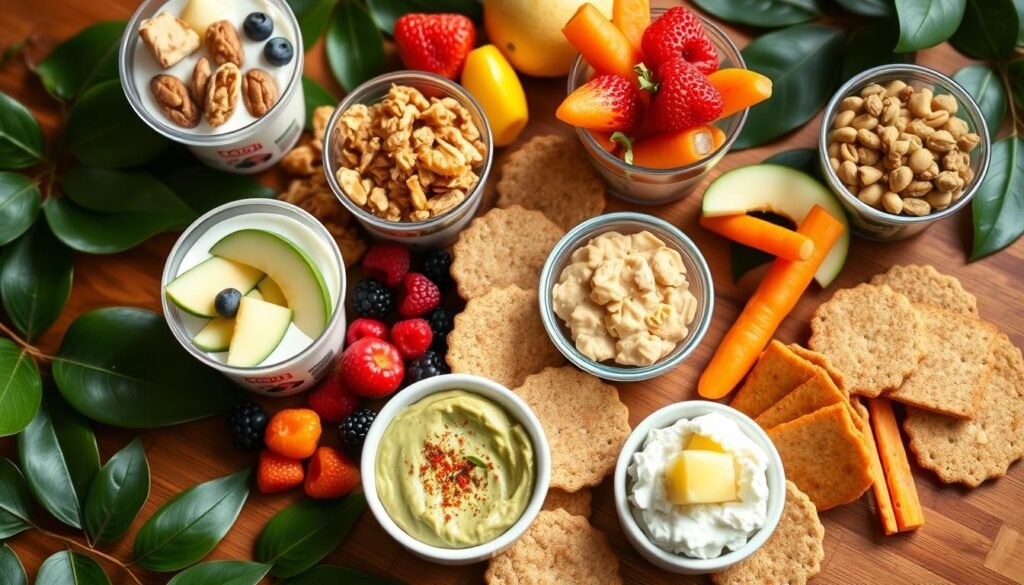Gestational Diabetes Carbs Per Meal : Gestational diabetes changes how your body handles sugar when you’re pregnant. It’s key for expectant moms to watch their carb intake to keep blood sugar levels healthy. This article will look at meal planning tips for those with gestational diabetes. Knowing the right carbs for each meal is crucial for both mom and baby’s health.
Key Takeaways
- Gestational diabetes requires careful carbohydrate management.
- Understanding what to eat at every meal is vital for blood sugar control.
- Meal planning can facilitate healthier eating during pregnancy.
- Monitoring carbs per meal helps maintain optimal health for both mother and baby.
- Consulting healthcare professionals is important for personalized dietary advice.
Understanding Gestational Diabetes
Gestational Diabetes Carbs Per Meal : Gestational diabetes is a condition that happens during pregnancy. It is caused by hormonal changes that help the body support the mother and the baby. Knowing about gestational diabetes early is key to managing its risks.
Several risk factors can lead to gestational diabetes. Women who are overweight are at a higher risk. Family history also plays a big role, especially if relatives have diabetes. Age matters too; women over 25 are more likely to get it.
Common symptoms include feeling very thirsty, needing to pee a lot, and feeling tired. These signs can be mistaken for normal pregnancy symptoms. But knowing them helps women get the right medical help.
| Risk Factor | Description |
|---|---|
| Obesity | Higher body mass index increases the risk of insulin resistance. |
| Family History | A direct link to the likelihood of developing diabetes in pregnancy. |
| Age over 25 | Increased hormone production can lead to glucose intolerance. |
What Role Do Carbohydrates Play?
Carbohydrates are a key energy source for our bodies, especially during pregnancy. They help us stay active and support the growth of the baby. It’s important for pregnant women to watch their carb intake to keep blood sugar levels in check.
Carbs turn into glucose, which increases blood sugar. Eating healthy carbs with lots of fiber helps slow down this process. Good choices include whole grains, fruits, and veggies.
Knowing the glycemic index (GI) of foods is key. Foods with a low GI raise blood sugar slowly, while high-GI foods cause quick spikes. Mixing carbs with protein and healthy fats keeps energy stable.
Here’s a breakdown of different carbohydrate types and their impact on blood sugar levels:
| Carbohydrate Type | Examples | Impact on Blood Sugar |
|---|---|---|
| Simple Carbohydrates | Sugary drinks, candy | Causes rapid spikes |
| Complex Carbohydrates | Whole grains, legumes | Leads to gradual increase |
| Fiber-Rich Carbohydrates | Fruits, vegetables | Stabilizes blood sugar levels |
Recommended Carbs Per Meal for Gestational Diabetes
Knowing how much carbohydrate to eat is key for managing gestational diabetes. Aim for 30 to 60 grams of carbs per meal. This helps meet dietary needs and keeps blood sugar stable. Carbs should make up 45-65% of your daily calories for best results.
Daily Carbohydrate Intake Guidelines
Carb intake for gestational diabetes varies based on individual needs. It’s important to follow guidelines for a healthy pregnancy. This balance provides enough energy without causing blood sugar spikes.
Distributing Carbs Throughout the Day
How you spread out carbs is crucial for blood sugar control. Eating smaller, more frequent meals helps keep glucose levels steady. This strategy helps manage daily carb intake and prevents blood sugar swings.
| Meal Type | Recommended Carbs (grams) |
|---|---|
| Breakfast | 30-45 |
| Lunch | 30-60 |
| Dinner | 30-60 |
| Snacks | 15-30 |
Gestational Diabetes Carbs Per Meal
Managing carbs is key for those with gestational diabetes. A careful carb calculation helps create a diet that fits your health needs. Your weight, activity level, and overall health all play a part in these calculations.
Calculating Your Ideal Carb Intake
Creating a carb plan starts with knowing your personal factors. First, figure out your daily calorie needs. Then, decide how much of those calories should come from carbs. Experts suggest 45-60% of daily calories should be carbs. But, this can vary based on your needs.
Tailoring Carbs to Individual Needs
Everyone’s needs are different, so a personalized approach is best. Your metabolic rate, lifestyle, and health history all impact carb intake. Carbohydrate counting helps adjust portions based on your health. This way, you can keep your blood sugar stable and still enjoy a wide range of foods.

Choosing the Right Carbohydrates
Managing gestational diabetes means making smart food choices about carbs. Knowing the difference between simple and complex carbs is key. Simple carbs in processed foods raise blood sugar fast. On the other hand, complex carbohydrates in whole grains, legumes, fruits, and veggies give steady energy and help control blood sugar.
Choosing healthy carbs is crucial for good nutrition during pregnancy. Eating whole grains like oatmeal, brown rice, and quinoa gives you fiber and nutrients. Fruits and veggies, full of vitamins and minerals, should be part of your diet too. Stay away from processed sugars and refined grains like white bread and sugary snacks to keep your blood sugar stable.
- Whole grain bread and pasta
- Brown rice and quinoa
- Legumes like lentils, chickpeas, and black beans
- Fresh fruits such as berries, apples, and oranges
- A variety of vegetables, especially leafy greens
By picking the right carbs, pregnant people can manage their blood sugar and stay healthy.
Low Glycemic Index Foods
Gestational Diabetes Carbs Per Meal : The glycemic index (GI) is key for managing blood sugar, especially for those with gestational diabetes. Foods with a low GI cause a slower and steadier rise in blood sugar. This helps keep blood sugar levels stable. It’s vital for planning meals and staying healthy.
Adding low glycemic index foods to your diet can be tasty and good for you. These include:
- Legumes such as lentils and chickpeas
- Whole grains like quinoa and barley
- Non-starchy vegetables, including broccoli and spinach
- Certain fruits, such as berries and cherries
These foods help control blood sugar and offer important nutrients. They’re great for making balanced meals. Learning about the low glycemic index can improve your health and make eating more enjoyable.

Meal Planning for Gestational Diabetes
Meal planning is key for managing gestational diabetes. It ensures each meal has carbs, proteins, and fats. This helps keep blood sugar stable and gives vital nutrients to mom and baby.
Creating Balanced Meals
To make balanced meals, include:
- Protein: Choose chicken, fish, eggs, or legumes for your body’s needs.
- Healthy Fats: Add avocados, nuts, or olive oil for heart health.
- Fiber: Whole grains, fruits, and veggies aid digestion and give nutrients.
- Carbohydrates: Pick low glycemic index foods like quinoa, brown rice, and sweet potatoes to control blood sugar.
Gestational Diabetes Carbs Per Meal : Each meal should mix these elements for nutritional balance and healthy weight. Balanced meals help women with gestational diabetes eat better.
Sample Meal Plans for the Week
Sample meal plans make planning easier with real examples. Here’s a week’s plan:
| Day | Breakfast | Lunch | Dinner |
|---|---|---|---|
| Monday | Oatmeal with berries | Grilled chicken salad | Baked salmon with quinoa and asparagus |
| Tuesday | Greek yogurt with nuts | Turkey and avocado wrap | Stir-fried tofu with brown rice and broccoli |
| Wednesday | Scrambled eggs with spinach | Lentil soup with whole grain bread | Chicken stir-fry with mixed vegetables |
| Thursday | Chia pudding with fruits | Quinoa salad with chickpeas | Crockpot beef stew with carrots |
| Friday | Smoothie with spinach and banana | Grilled shrimp with vegetable skewers | Stuffed bell peppers with ground turkey |
| Saturday | Pancakes made with almond flour | Vietnamese rice noodle salad | Roasted chicken with sweet potatoes |
| Sunday | Fruit and nut oatmeal | Vegetable and bean chili | Baked cod with a side of brown rice |
Using these meal plans can make cooking easier. It keeps meals nutritious and balanced. Making choices that fit your diet and taste can make meal planning a breeze, helping manage gestational diabetes.
Healthy Snack Options
Gestational Diabetes Carbs Per Meal : Choosing the right snacks is key to managing gestational diabetes and getting the right nutrition. It’s important to pick snacks that curb cravings and keep blood sugar stable. Snacks that are both nutritious and filling are best for your health.

- Nuts: Almonds, walnuts, and pistachios are full of healthy fats and protein. They’re great for feeling full.
- Yogurt: Choose plain Greek yogurt for its high protein and low sugar. Add berries for extra vitamins.
- Hummus with Vegetables: Hummus with carrots, cucumbers, or bell peppers is a tasty and fiber-rich choice.
- Fruit with Nut Butter: Apple or banana slices with almond or peanut butter are delicious and nutritious.
Choosing these snacks helps you stay full between meals and manage gestational diabetes well. Focusing on nutrition is good for a healthy pregnancy and long-term health.
Foods to Avoid with Gestational Diabetes
Gestational Diabetes Carbs Per Meal : Keeping a healthy diet is key for both mom and baby with gestational diabetes. Some foods can cause blood sugar to spike. Knowing which foods to avoid is crucial for managing the condition.
- Sugary Beverages: Drinks like soft drinks and sweetened juices can quickly raise blood sugar levels.
- White Bread and Pastries: These foods are high in refined carbs and can cause insulin resistance.
- Candy and Sweets: These snacks are full of sugar but offer little nutritional value.
- High-Fat Processed Foods: These foods are often high in unhealthy fats, leading to weight gain and heart problems.
- Full-Fat Dairy Products: These may have too much saturated fat, which is not good.
Avoiding these foods helps manage blood sugar and follow a healthier diet. Making smart food choices can greatly improve health and pregnancy outcomes.
Tips for Eating Out
Dining out can be tough for those with gestational diabetes. To enjoy meals while watching carbs, here are some helpful tips.
- Review the menu ahead of time. Understand available options and select dishes that fit your dietary needs.
- Communicate with restaurant staff. Ask about preparation methods, such as grilled versus fried items.
- Opt for whole food options whenever possible. Salads, grilled proteins, and vegetable sides are often safer choices.
- Share portions. If the serving sizes are large, consider splitting a meal or taking leftovers home to avoid overeating.
- Be cautious with sauces and dressings. Request them on the side to control the amount consumed.
By following these tips, you can enjoy dining out without harming your health. Being proactive with your choices makes every meal a pleasure while managing gestational diabetes.
| Tip | Description |
|---|---|
| Menu Review | Familiarize yourself with available dishes to align with your dietary goals. |
| Staff Communication | Inquire about cooking methods and ingredients for better choices. |
| Whole Food Choices | Select grilled proteins and fresh vegetables over processed items. |
| Portion Control | Share meals to manage carbohydrate intake effectively. |
| Sauce Management | Ask for sauces on the side to regulate sugar and carb content. |
Monitoring Blood Sugar Levels
Gestational Diabetes Carbs Per Meal : Regular blood sugar monitoring is key in managing gestational diabetes. It helps track how foods and activities affect your body. This knowledge is crucial for making healthy food choices.
Self-testing with glucometers is easy and convenient. These devices let you check your blood sugar at home. Knowing how to read these results is also important for managing your diabetes.
Testing regularly helps spot any needed changes. A set schedule for testing helps see how meals and exercise affect your blood sugar. Here are some tips for successful testing:
- Test at various times: Before meals, after eating, and before bedtime.
- Record results: Keeping a log helps spot trends over time.
- Consult resources: Guides on blood sugar ranges can help you understand better.
By following these tips, you can better manage your health. Effective blood sugar monitoring leads to smarter choices and supports your well-being during pregnancy.
Consulting with Healthcare Professionals
Working with healthcare professionals is key to managing gestational diabetes well. A registered dietitian helps create a diet plan that fits your needs. They guide on what foods to choose for a healthy pregnancy.
Regular talks with healthcare pros help adjust diets based on health checks. This way, you see how food affects your sugar levels. Working with them boosts nutrition and supports a healthy pregnancy.
“A healthy diet during pregnancy is vital; working with a registered dietitian can make a significant difference.”
Healthcare experts focus on your likes and lifestyle when planning meals. This makes eating habits that last for you and your baby. Their support and advice help manage gestational diabetes well.
| Healthcare Professionals | Role in Pregnancy Health | Benefits |
|---|---|---|
| Obstetricians | Monitor overall health and development | Safe pregnancy outcomes |
| Registered Dietitians | Create tailored meal plans | Balanced nutrition for mother and baby |
| Diabetes Educators | Provide education on blood sugar monitoring | Empowerment and self-management |
Getting help from healthcare professionals meets your diet needs now and for the future. It’s a smart move for a healthier pregnancy journey.
Conclusion
Gestational Diabetes Carbs Per Meal : Managing gestational diabetes means watching what you eat, especially carbs. We’ve talked about how carbs are key in pregnancy nutrition. It’s important to pick the right carbs and the right amount for your health and your baby’s.
Creating a meal plan that fits you can make a big difference. It helps keep your blood sugar stable. We’ve given you tips on meal planning and healthy snacks to help you manage your diet.
Every pregnancy is different, so a one-size-fits-all plan won’t work. Tailoring your nutrition to your needs is the best way to go. Stay informed, stay proactive, and enjoy your journey to a healthier pregnancy.




